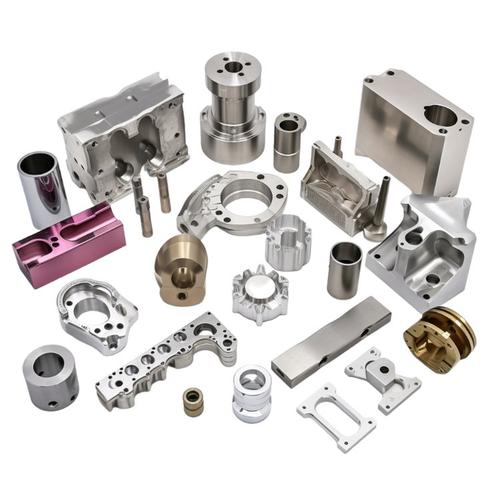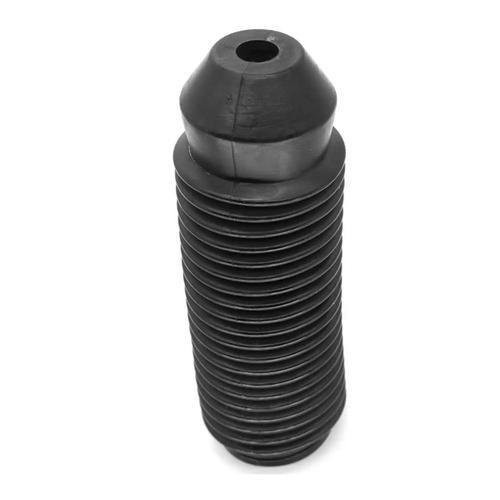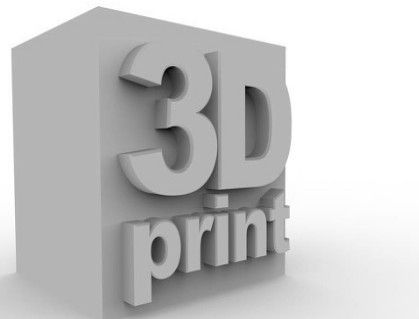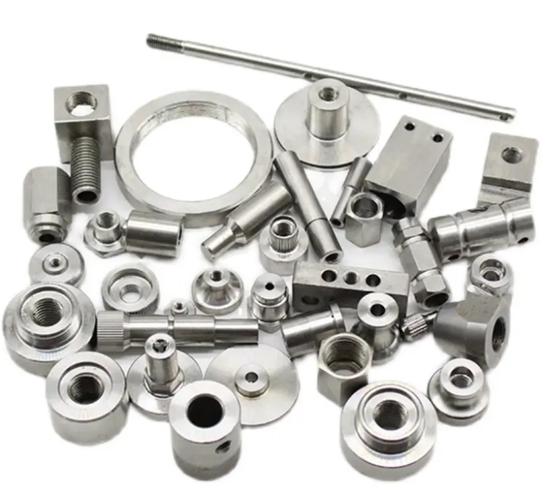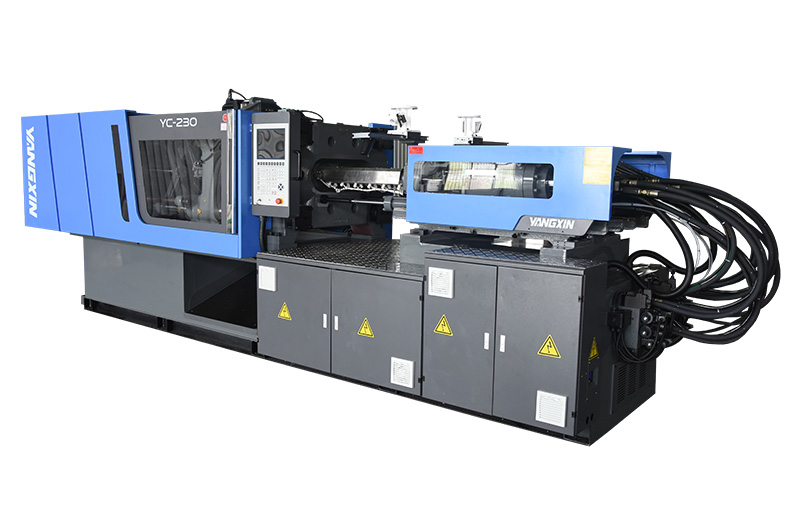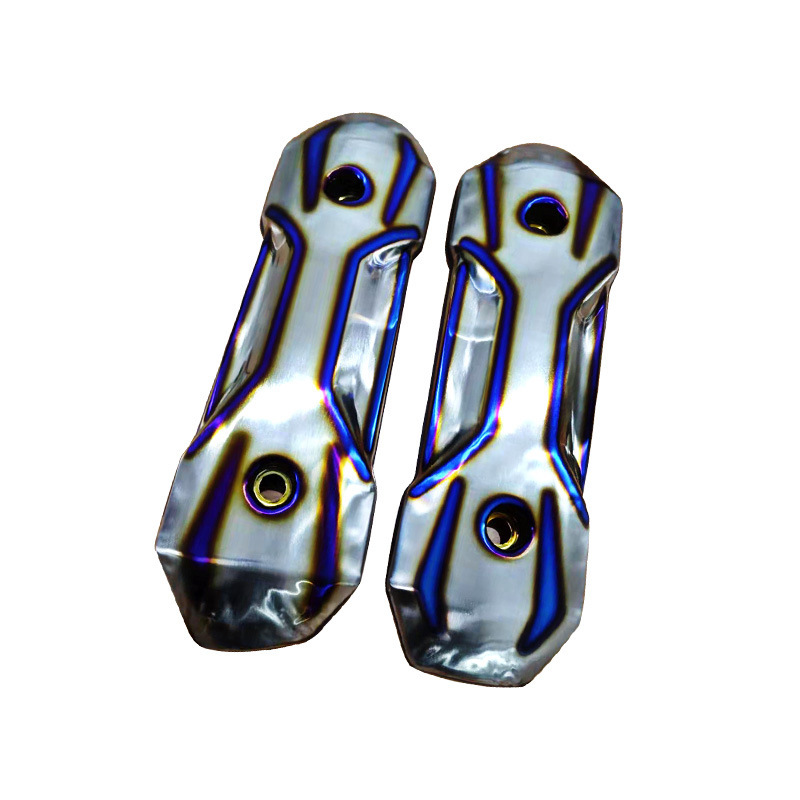I. Introduction
5-axis CNC machining is one of the most precise and powerful manufacturing technologies in modern manufacturing industry. It can complete the machining of complex curved surfaces in a single setup, significantly improving machining efficiency and quality. With the increasing demand for high-precision and high-complexity parts in the manufacturing industry, 5-axis CNC machining technology is gradually becoming the preferred process for manufacturing key components in various industries. This report will comprehensively analyze the application data performance of 5-axis CNC machining in different industries and materials, compare the advantages and limitations of traditional machining methods, and provide references for manufacturing decision-makers.
II. Overview of 5-Axis CNC Machining Technology
2.1 Technical Principles and Characteristics
5-axis CNC machining refers to the addition of two rotational axes (usually A-axis and C-axis) on the basis of the traditional 3-axis (X, Y, Z) linear movement, enabling the synchronous movement of the tool or workpiece in five degrees of freedom. This technology allows the tool to approach the workpiece surface from any angle, greatly improving the ability to machine complex curved surfaces. Compared with traditional 3-axis machining, 5-axis machining has the following significant advantages:
- Multi-face machining in one setup: Reduces cumulative errors caused by multiple setups of workpieces, improving machining accuracy and consistency.
- Complex curved surface machining capability: Can achieve complex curved surface and deep cavity machining that cannot be completed by traditional 3-axis machining.
- Improved machining efficiency: Reduces empty travel through optimized tool paths, shortening the machining cycle.
- Extended tool life: Maintains optimal cutting angles, reducing tool wear and breakage.
2.2 Machining Accuracy and Surface Quality
Modern high-end 5-axis CNC machine tools have achieved amazing precision levels. According to the latest technical data, the positioning accuracy of top 5-axis machine tools in 2025 can reach ±0.001mm, and the repeatability accuracy can reach ±0.0005mm. This level of precision has approached or exceeded many traditional precision machining methods. In terms of surface quality, the surface roughness (Ra) achievable by 5-axis machining is usually between 0.4-0.8μm, and some high-precision machining can even reach 0.1-0.2μm.
III. Data Analysis of 5-Axis CNC Machining Applications in Various Industries
3.1 Aerospace Industry
Aerospace is one of the most important application fields of 5-axis CNC machining, mainly used for manufacturing high-precision complex parts such as turbine blades, integral blisks, and structural frames.
Machining characteristics:
- Materials: Mainly titanium alloys, superalloys (such as Inconel 718), and composite materials.
- Accuracy requirements: Usually within ±0.005mm, with surface roughness around Ra 0.4μm.
- Machining challenges: Materials are difficult to cut, with large machining allowances, usually requiring removal of 90%-95% of the material.
Data performance:
- Machining efficiency: After using a 5-axis gantry machining center in an aerospace manufacturing enterprise, the machining cycle of aircraft structural parts was shortened from 72 hours to 32 hours, with an efficiency improvement of 3 times.
- Accuracy improvement: The machining accuracy of engine casings was improved by 40%, and the processing qualification rate of composite components reached 99.2%.
- Material removal rate: In aerospace aluminum alloy machining, the average material removal rate (MRR) of 5-axis machining can reach 11,642 cm³/min.
- Surface quality: The surface roughness of titanium alloy impellers can reach Ra 0.4μm, meeting the requirements of aero-engines.
Case analysis: In the C919 large aircraft project, domestic 5-axis machine tools undertook 70% of the titanium alloy structural part machining tasks, with a single equipment saving more than 20 million yuan in foreign exchange annually. After an enterprise adopted Kede CNC equipment, the machining cost of engine integral blisks was reduced from 12 million yuan per unit to 7 million yuan, and the delivery cycle was shortened by 60%.
3.2 Medical Industry
The medical industry is another important application field of 5-axis CNC machining, mainly used for manufacturing high-precision medical devices such as orthopedic implants, dental implants, and surgical instruments.
Machining characteristics:
- Materials: Mainly biocompatible materials such as titanium alloys, stainless steels, and PEEK.
- Accuracy requirements: Usually requiring accuracy within ±0.01mm, with surface roughness below Ra 0.4μm.
- Machining challenges: Extremely high requirements for biocompatibility and surface quality, needing to meet strict medical certification standards.
Data performance:
- Machining efficiency: Completing multi-face machining in a single setup saves about 30%-50% of setup time; the machining cycle of complex parts can be shortened by more than 40%.
- Accuracy performance: 5-axis machining can achieve micron-level accuracy (within ±5μm), meeting the strict tolerance requirements of the medical industry (such as ISO 2768-mK level).
- Material utilization: Through adaptive cutting path planning, the utilization rate of expensive materials such as titanium alloys and PEEK is increased by 15%-25%.
- Surface quality: Can directly machine bio-grade surfaces with surface roughness (Ra) up to 0.4μm or less, reducing subsequent polishing processes.
Case analysis: An orthopedic manufacturer adopted 5-axis machining for titanium alloy spinal fixators, integrating the original 7 processes into 1 setup, and the yield rate increased from 82% to 98%. In dental implant machining, 5-axis technology reduced the loss of titanium alloy bars from 50% in traditional processes to 30%.
3.3 Automobile Manufacturing Industry
The automobile industry is one of the most widely used fields of 5-axis CNC machining, mainly used for manufacturing complex components such as engine blocks, cylinder heads, mold inserts, and lightweight structural parts.
Machining characteristics:
- Materials: Mainly aluminum alloys, magnesium alloys, cast iron, and mold steels.
- Accuracy requirements: Usually around ±0.01mm, with surface roughness Ra 0.8-1.6μm.
- Machining challenges: High requirements for stability and consistency in mass production, needing to balance accuracy, efficiency, and cost.
Data performance:
- Machining efficiency: 5-axis linkage technology compressed the automobile mold machining cycle from 15 days to 5 days, with an efficiency improvement of 66%.
- Accuracy performance: The machining accuracy of automotive aluminum alloy structural parts can reach ±0.01mm, meeting automotive assembly requirements.
- Material removal rate: In aluminum alloy machining, the material removal rate of 5-axis machining can reach 1,001 cubic inches per minute (about 16,400 cm³/min).
- Cost-effectiveness: After an enterprise adopted 5-axis machining, the machining cost of wind power gearboxes was reduced by 35%.
Case analysis: A new energy vehicle company used 5-axis machining for battery trays, reducing the defective rate by 20% and increasing production capacity by 30%. In automobile mold manufacturing, 5-axis machining can shorten the mold production cycle from 15 days to 5 days, greatly accelerating the development speed of new vehicle models.
3.4 Mold Manufacturing Industry
Mold manufacturing is a traditional application field of 5-axis CNC machining, mainly used for manufacturing complex molds such as injection molds, die-casting molds, and stamping molds.
Machining characteristics:
- Materials: Mainly mold steels, hot work steels, cold work steels, etc.
- Accuracy requirements: Usually within ±0.01mm, with surface roughness Ra 0.4-0.8μm.
- Machining challenges: Complex mold cavities, with high requirements for surface quality and dimensional accuracy.
Data performance:
- Machining efficiency: A case showed that 5-axis machining compressed the mold development cycle by 30% and reduced electrode loss by 60%.
- Accuracy performance: The dimensional accuracy of complex cavities can be stably controlled within ±0.005mm.
- Surface quality: Mirror-level surfaces can be directly achieved through 5-axis machining, reducing or even eliminating polishing processes.
- Material removal rate: In steel material machining, the material removal rate of 5-axis milling can reach 672 cm³/min.
Case analysis: In the production of a certain automobile lamp mold, 5-axis linkage machining achieved mirror-level polishing effect directly on the mold core surface through 5-axis linkage milling of inclined surfaces, eliminating the traditional manual polishing process, greatly shortening the mold production cycle and improving mold quality.
3.5 Medical Industry
The medical industry is another important application field of 5-axis CNC machining, mainly used for manufacturing high-precision medical devices such as orthopedic implants, dental implants, and surgical instruments.
Machining characteristics:
- Materials: Mainly biocompatible materials such as titanium alloys, stainless steels, and PEEK.
- Accuracy requirements: Usually requiring accuracy within ±0.01mm, with surface roughness below Ra 0.4μm.
- Machining challenges: Extremely high requirements for biocompatibility and surface quality, needing to meet strict medical certification standards.
Data performance:
- Machining efficiency: Completing multi-face machining in a single setup saves about 30%-50% of setup time; the machining cycle of complex parts can be shortened by more than 40%.
- Accuracy performance: 5-axis machining can achieve micron-level accuracy (within ±5μm), meeting the strict tolerance requirements of the medical industry (such as ISO 2768-mK level).
- Material utilization: Through adaptive cutting path planning, the utilization rate of expensive materials such as titanium alloys and PEEK is increased by 15%-25%.
- Surface quality: Can directly machine bio-grade surfaces with surface roughness (Ra) up to 0.4μm or less, reducing subsequent polishing processes.
Case analysis: An orthopedic manufacturer adopted 5-axis machining for titanium alloy spinal fixators, integrating the original 7 processes into 1 setup, and the yield rate increased from 82% to 98%. In dental implant machining, 5-axis technology reduced the loss of titanium alloy bars from 50% in traditional processes to 30%.
3.6 Other Industry Applications
Energy equipment industry:
- The profile accuracy of large gas turbine blades can reach 0.02mm.
- The machining cycle of nuclear power main pump casings is shortened by 60%.
- The machining cost of wind power gearboxes is reduced by 35%.
Woodworking industry:
- Machining accuracy can reach ±0.05mm, and machining speed can reach 1000mm/min.
- The machining efficiency of special-shaped wooden components is improved. In a homestay project, the machining time of 200 special-shaped wooden components was shortened from 10 days with traditional processes to 3 days.
- Material utilization is increased by 25%, and a solid wood flooring factory saves more than 500,000 yuan in raw material costs annually.
Electronics/Optics industry:
- The machining accuracy of optical lens molds can reach ±0.002mm.
- The machining accuracy requirements for semiconductor manufacturing device housings are extremely high, usually within ±0.005mm.
- Excellent micro-hole machining capability, capable of machining holes with a diameter of 0.5mm and an aspect ratio of 10:1.
IV. Performance Analysis of 5-Axis CNC Machining for Different Materials
4.1 Metal Material Machining
Titanium alloy (Ti-6Al-4V):
- Machining difficulties: Poor thermal conductivity, easy chemical reaction with tools, high cutting temperature.
- Machining parameters: Cutting speed is usually 50-100m/min, feed rate 0.05-0.15mm/r.
-
- Accuracy can reach ±0.005mm, surface roughness Ra 0.4-0.8μm.
-
- Material removal rate can reach 672 cm³/min (end milling).
-
- Tool life is relatively short, requiring the use of special coated tools.
Aluminum alloys (such as 7075, 6061):
- Machining characteristics: Soft material, easy to cut, but prone to built-up edge, affecting surface quality.
- Machining parameters: Cutting speed can reach 200-500m/min, feed rate 0.1-0.3mm/r.
-
- Accuracy can reach ±0.01mm, surface roughness Ra 0.8-1.6μm.
-
- Extremely high material removal rate, up to 16,400 cm³/min.
-
- High machining efficiency, suitable for high-speed cutting.
Mold steels (such as H13, P20):
- Machining characteristics: High hardness, requiring good tool rigidity, usually machined after heat treatment.
- Machining parameters: Cutting speed is usually 30-80m/min, feed rate 0.05-0.1mm/r.
-
- Accuracy can reach ±0.005mm, surface roughness Ra 0.4-0.8μm.
-
- Usually requires multiple processes: roughing, semi-finishing, and finishing.
-
- Tools need to be made of cemented carbide or CBN materials.
Superalloys (such as Inconel 718):
- Machining characteristics: High high-temperature strength, poor thermal conductivity, severe work hardening.
- Machining parameters: Cutting speed is usually below 50m/min, feed rate 0.05-0.1mm/r.
-
- High machining difficulty, fast tool wear.
-
- Usually requires special cooling and lubrication methods.
-
- Low material removal rate, about 1/5-1/10 of that of aluminum alloys.
4.2 Non-Metal Material Machining
Carbon fiber composites:
- Machining characteristics: Anisotropic, weak interlayer bonding, prone to delamination and tearing.
- Machining parameters: Cutting speed is usually 80-150m/min, feed rate 0.1-0.2mm/r.
-
- High surface quality requirements, usually requiring PCD or diamond-coated tools.
-
- After machining, the surface roughness Ra can be reduced from 2011nm to 512nm, a decrease of 75%.
-
- Requires specially designed tool geometry and cutting parameters.
Engineering plastics (such as PEEK):
- Machining characteristics: Strong thermal sensitivity, easy to deform, high requirements for machining temperature control.
- Machining parameters: Cutting speed is usually 50-100m/min, feed rate 0.1-0.2mm/r.
-
- Accuracy can reach ±0.01mm, surface roughness Ra 0.8-1.6μm.
-
- Ultra-high precision PEEK part machining of 0.01mm has been achieved.
-
- Material removal rate can reach 1500 mm³/min.
Wood:
- Machining characteristics: Inhomogeneous material, with knots, texture changes, etc.
- Machining parameters: Cutting speed is usually 100-300m/min, feed rate 0.2-0.5mm/r.
-
- Machining accuracy can reach ±0.05mm, machining speed can reach 1000mm/min.
-
- Surface quality is greatly affected by wood texture, requiring adjustment of tool paths and cutting parameters.
-
- Material utilization is increased by 25%, and machining efficiency is improved by more than 50%.
Ceramic materials:
- Machining characteristics: High hardness, high brittleness, prone to cracking.
- Machining parameters: Cutting speed is usually 20-50m/min, feed rate 0.02-0.05mm/r.
-
- Requires diamond or CBN tools, usually requiring multiple passes.
-
- After machining, the surface roughness Ra can reach 0.4-0.8μm.
-
- Excellent micro-hole machining capability, capable of machining holes with a diameter of 0.5mm and an aspect ratio of 10:1.
V. Comparative Analysis of 5-Axis CNC Machining with Other Machining Methods
5.1 5-Axis CNC Machining vs 3-Axis CNC Machining
Accuracy comparison:
- 5-axis machining: Positioning accuracy can reach ±0.001mm, repeatability accuracy ±0.0005mm.
- 3-axis machining: Positioning accuracy is usually ±0.01-0.02mm, repeatability accuracy ±0.005-0.01mm.
- Advantage analysis: 5-axis machining completes multi-face machining in one setup, reducing setup errors and improving overall accuracy.
Surface quality comparison:
- 5-axis machining: Surface roughness Ra is usually 0.4-0.8μm, capable of achieving mirror effects.
- 3-axis machining: Surface roughness Ra is usually 1.6-3.2μm, requiring more subsequent polishing processes.
- Advantage analysis: 5-axis machining can maintain a constant tool contact angle, reducing tool vibration and improving surface quality.
Machining efficiency comparison:
- 5-axis machining: Machining cycle can be shortened by 40-60%, setup time reduced by 70%.
- 3-axis machining: Requires multiple setups and tool changes, with a longer machining cycle.
- Advantage analysis: 5-axis machining reduces the number of setups and empty travels, improving production efficiency.
Cost comparison:
- 5-axis machining: High equipment cost, usually 2-3 times that of 3-axis equipment, but low long-term comprehensive cost.
- 3-axis machining: Lower equipment cost, but requires more manual intervention and post-processing.
- Advantage analysis: Although 5-axis machining has a high initial investment, it reduces labor and post-processing costs and improves yield rates.
5.2 5-Axis CNC Machining vs Electrical Discharge Machining (EDM)
Material applicability comparison:
- 5-axis machining: Suitable for various metal and non-metal materials, especially suitable for materials with not too high hardness.
- EDM machining: Suitable for any conductive material, especially suitable for high-hardness, complex-shaped parts.
- Advantage analysis: 5-axis machining has wider material adaptability, while EDM is suitable for machining high-hardness materials.
Accuracy comparison:
- 5-axis machining: Accuracy can reach ±0.001mm, surface roughness Ra 0.4-0.8μm.
- EDM machining: Accuracy can reach ±0.002mm, surface roughness Ra 0.2-0.8μm.
- Advantage analysis: Both have similar accuracy, and EDM may have advantages in micro-structure machining.
Material removal rate comparison:
- 5-axis machining: Aluminum alloy machining can reach 16,400 cm³/min, and steel material can reach 672 cm³/min.
- EDM machining: The material removal rate for titanium alloy machining is usually 3.2-7.75 mm³/min.
- Advantage analysis: The material removal rate of 5-axis machining is much higher than that of EDM, with higher machining efficiency.
Machining cost comparison:
- 5-axis machining: Suitable for mass production, with unit cost decreasing as production volume increases.
- EDM machining: High equipment and electrode costs, slow machining speed, and high unit cost.
- Advantage analysis: 5-axis machining has obvious cost advantages in mass production, while EDM is more cost-effective in small-batch, complex-shaped machining.
Surface integrity comparison:
- 5-axis machining: No heat-affected zone, good surface quality, no change in material properties.
- EDM machining: May produce white layers and micro-cracks, requiring subsequent treatment.
- Advantage analysis: 5-axis machining is superior to EDM in terms of surface integrity.
5.3 5-Axis CNC Machining vs Precision Casting
Accuracy comparison:
- 5-axis machining: Positioning accuracy can reach ±0.001mm, repeatability accuracy ±0.0005mm.
- Precision casting: Accuracy is usually ±0.08-0.2mm, and high-precision casting can reach ±0.05mm.
- Advantage analysis: The accuracy of 5-axis machining is significantly higher than that of precision casting.
Surface quality comparison:
- 5-axis machining: Surface roughness Ra is usually 0.4-0.8μm.
- Precision casting: Surface roughness Ra is usually 3.2-6.3μm, and non-ferrous metals can reach 1.6-3.2μm.
- Advantage analysis: The surface quality of 5-axis machining is much better than that of precision casting.
Machining cycle comparison:
- 5-axis machining: Short single-piece machining cycle, and the machining cycle of complex parts can be shortened by more than 40%.
- Precision casting: Long mold development cycle, long production preparation time, but high efficiency in mass production.
- Advantage analysis: 5-axis machining has a shorter cycle in small-batch, multi-variety production, while casting has advantages in mass production.
Cost comparison:
- 5-axis machining: High initial investment, but low production cost for small batches.
- Precision casting: High mold cost, but low production cost for large batches.
- Advantage analysis: 5-axis machining is more economical for small-batch production, and casting has cost advantages for large-batch production.
Material utilization comparison:
- 5-axis machining: Material utilization rate is usually 5-10%, especially for aerospace structural parts.
- Precision casting: Material utilization rate can reach 60-70%, close to net shape forming.
- Advantage analysis: Precision casting is significantly superior to 5-axis machining in terms of material utilization.
5.4 5-Axis CNC Machining vs 3D Printing
Material limitation comparison:
- 5-axis machining: Almost applicable to all machinable materials, including metals, plastics, wood, etc.
- 3D printing: Limited materials, mainly metal powders, thermoplastics, resins, etc.
- Advantage analysis: 5-axis machining has more flexibility in material selection.
Accuracy comparison:
- 5-axis machining: Accuracy can reach ±0.001mm, surface roughness Ra 0.4-0.8μm.
- 3D printing: Accuracy is usually ±0.1-0.2mm, surface roughness Ra 5-10μm.
- Advantage analysis: 5-axis machining is significantly superior to 3D printing in accuracy and surface quality.
Production efficiency comparison:
- 5-axis machining: Suitable for single-piece and small-batch production, with high production efficiency.
- 3D printing: Suitable for single-piece production of complex structures, but low efficiency in mass production.
- Advantage analysis: 5-axis machining is more efficient in mass production.
Complex structure machining capability comparison:
- 5-axis machining: Suitable for machining complex curved surfaces and deep cavities, but internal structures are limited.
- 3D printing: Can directly manufacture complex internal structures and hollow designs.
- Advantage analysis: 3D printing has unique advantages in manufacturing complex internal structures.
Cost comparison:
- 5-axis machining: High initial investment, but unit cost decreases as production volume increases.
- 3D printing: High equipment and material costs, but low mold costs.
- Advantage analysis: 5-axis machining has obvious cost advantages in mass production, while 3D printing is more cost-effective for single complex structures.
VI. Development Trends of 5-Axis CNC Machining Technology
6.1 Accuracy and Efficiency Improvement
- Accuracy improvement: The positioning accuracy of top 5-axis machine tools has reached ±0.001mm in 2025, and will develop towards nanoscale accuracy in the future.
-
- Spindle speed continues to increase, reaching 24,000-30,000rpm in 2025.
-
- Rapid feed speed can reach 48m/min, with acceleration up to 1.2G.
-
- Material removal rate continues to increase, with aluminum alloy machining reaching 16,400 cm³/min.
-
- Artificial intelligence and machine learning technologies are applied to tool path optimization to improve machining efficiency and quality.
-
- Real-time monitoring systems automatically adjust machining parameters to achieve adaptive machining.
6.2 Intelligentization and Automation
-
- AI-based CNC systems can real-time optimize machining paths and dynamically compensate for errors caused by thermal deformation.
-
- Artificial intelligence algorithms optimize cutting parameters to improve material removal rate and surface quality.
-
- Automated loading and unloading systems reduce manual intervention and improve production efficiency.
-
- The concept of unmanned factories is gradually popularized to achieve 24-hour uninterrupted production.
-
- Build a virtual simulation machining environment to improve machining accuracy and resource utilization by simulating wood characteristics and process parameters.
-
- Predictive maintenance systems reduce equipment failure rates and improve production continuity.
6.3 Hybrid Manufacturing Technology
- Additive-subtractive composite machining:
-
- Combination of 5-axis machining and 3D printing to achieve “additive + subtractive” composite manufacturing.
-
- A hybrid manufacturing system developed by an enterprise can complete additive and subtractive machining on one equipment, increasing material utilization by 5 times.
- Laser-cutting composite machining:
-
- Integration of laser heat treatment and cutting machining to improve machining efficiency and surface quality.
-
- Laser-assisted cutting reduces cutting force and temperature, suitable for difficult-to-machine materials.
- Electrochemical-mechanical composite machining:
-
- Combining the advantages of electrochemical machining and mechanical machining to improve machining efficiency and surface quality.
-
- In titanium alloy machining, the material removal rate of composite dielectric machining is 3.63 times higher than that of pure electrical discharge machining.
6.4 Green Manufacturing and Sustainable Development
- Energy-saving technology:
-
- Energy-saving spindle design, standby power reduced from 1.2kW to 0.3kW, saving about 36,000 yuan in electricity bills annually.
-
- Dry cutting technology reduces cutting fluid consumption by 90%, reducing environmental pollution.
- Material utilization improvement:
-
- 5-axis machining path optimization reduces material waste and improves raw material utilization.
-
- Special processes such as trochoidal milling and spiral progressive strategies improve material removal rate and reduce energy consumption.
- Intelligent manufacturing system:
-
- Energy management systems optimize production scheduling to reduce overall energy consumption.
-
- Cutting fluid recycling and reuse systems reduce waste emissions.
VII. Conclusions and Recommendations
7.1 Main Conclusions
- Obvious accuracy advantages: 5-axis CNC machining has significant advantages in accuracy and surface quality, with positioning accuracy up to ±0.001mm and surface roughness Ra up to 0.4μm or less, far exceeding traditional machining methods such as 3-axis machining, EDM, and precision casting.
- Balance between efficiency and cost: Although 5-axis machining equipment investment is high, through reducing the number of setups, shortening the machining cycle, and improving yield rates, the long-term comprehensive cost is competitive, especially suitable for small-batch production of high-precision, complex-shaped parts.
- Wide material adaptability: 5-axis machining can adapt to the machining of various materials from metals to non-metals, especially performing well in machining difficult-to-machine materials such as titanium alloys, superalloys, and composite materials.
- Significant differences in industry applications: Different industries have different requirements and application focuses for 5-axis machining. The aerospace industry focuses on accuracy and surface quality, the automotive industry focuses on efficiency and cost, and the medical industry focuses on accuracy and biocompatibility.
- Continuous technological progress: 5-axis machining technology is developing towards higher accuracy, higher efficiency, more intelligent, and greener directions. New technologies such as AI integration, digital twins, and hybrid manufacturing will further improve its performance.
7.2 Application Recommendations
Recommendations for manufacturers:
- Reasonable selection of machining methods: According to part characteristics, production batch, and accuracy requirements, reasonably select 5-axis machining, 3-axis machining, EDM, or casting and other machining methods. For high-precision, complex-shaped small-batch parts, 5-axis machining is usually the best choice.
- Optimization of process routes:
-
- Make full use of the advantage of 5-axis machining to complete multi-face machining in one setup, reducing the number of setups.
-
- Reasonably plan roughing, semi-finishing, and finishing processes, and optimize tool paths.
-
- Select appropriate tools and cutting parameters according to material characteristics.
- Equal emphasis on investment and talents:
-
- When investing in high-precision 5-axis equipment, consider the accuracy retention, stability, and after-sales service of the equipment.
-
- Cultivate professional talents mastering 5-axis programming and operation to give full play to equipment potential.
Recommendations for industries:
- Aerospace industry:
-
- Adopt 5-axis machining more to replace traditional machining methods to improve the accuracy and quality of complex structural parts.
-
- Pay attention to the development of hybrid manufacturing technology and explore the application of additive-subtractive composite machining.
- Automotive industry:
-
- Promote 5-axis machining in mold manufacturing to shorten mold development cycles and improve mold accuracy.
-
- Use 5-axis machining to develop lightweight structural parts to reduce vehicle weight and improve fuel efficiency.
- Medical industry:
-
- Expand the application of 5-axis machining in the manufacturing of customized implants and surgical instruments.
-
- Pay attention to the technical development of combining 5-axis machining with 3D scanning and AI modeling to promote the development of personalized medical care.
Future outlook:
With the continuous progress of technology, 5-axis CNC machining will play an important role in a wider range of fields. In the next 5-10 years, we will see higher-precision, higher-efficiency, and more intelligent 5-axis machining technology, as well as in-depth integration with other advanced manufacturing technologies, bringing new changes to the global manufacturing industry.
5-axis CNC machining is not only a machining technology but also an important driving force for promoting product innovation and manufacturing method reform, and will continue to lead the development direction of high-precision, complex-shaped part manufacturing.
